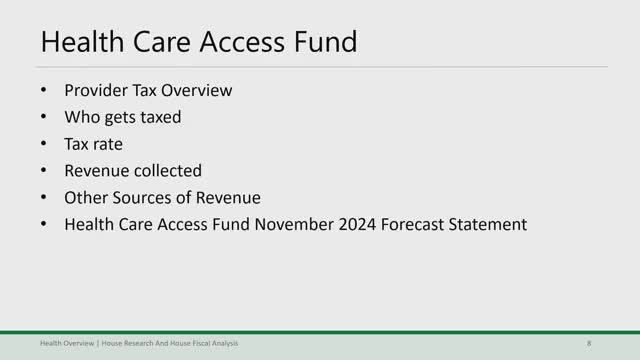House staff brief lawmakers on Health Care Access Fund, provider tax projections
January 15, 2025 | 2025 Legislature MN, Minnesota
This article was created by AI summarizing key points discussed. AI makes mistakes, so for full details and context, please refer to the video of the full meeting. Please report any errors so we can fix them. Report an error »

House nonpartisan fiscal staff told members of the Minnesota House Health Finance and Policy Work Group on Jan. 15 that the Health Care Access Fund, financed mainly by the provider tax, pays for portions of Medical Assistance and MinnesotaCare and supports other public-health activities.
Why it matters: The Health Care Access Fund is a recurring revenue source for state-subsidized health coverage; changes to provider-tax receipts affect the fund's capacity to cover programs and the committee's appropriation choices.
Joe Herving, a House Fiscal staff member, said the provider tax is an imposition on gross revenues of many health-care providers — licensed professionals, hospitals, ambulance services and wholesale drug distributors among them — and that the fund’s largest outlays are for Medical Assistance. Herving said the provider tax rate was 1.8% for calendar year 2024 but noted the rate can be reduced by the Management and Budget commissioner in consultation with the Revenue commissioner based on a fiscal balancing calculation; he said the rate was reduced to 1.6% in 2023 once in recent memory.
Herving provided revenue figures printed in the committee packet: the provider tax yielded about $751,000,000 in 2024, with a November-forecast estimate of roughly $824,000,000 for fiscal year 2025 and projected revenues of about $860,000,000 for fiscal year 2026 and $902,000,000 for fiscal year 2027. He also noted a separate gross-premium tax — a 1% assessment on premiums for HMOs, nonprofit health-service plan corporations and community integrated service networks — that is deposited into the same account.
Staff emphasized that certain federal Basic Health Program (BHP) dollars flow 1:1 into and out of a trust and that the Legislature’s authority to reallocate those specific BHP trust dollars is very limited. The staff presentation and accompanying November 2024 forecast spreadsheet in the committee packet visualize how the fund’s largest expenditures follow the forecast and that a large portion is dedicated to Medical Assistance.
The packet and slides also list other revenue sources and the fund’s roles in paying for program administration and grants intended to enhance public health services.
The briefing was informational; no committee action or vote on the fund was taken at the Jan. 15 meeting.
Why it matters: The Health Care Access Fund is a recurring revenue source for state-subsidized health coverage; changes to provider-tax receipts affect the fund's capacity to cover programs and the committee's appropriation choices.
Joe Herving, a House Fiscal staff member, said the provider tax is an imposition on gross revenues of many health-care providers — licensed professionals, hospitals, ambulance services and wholesale drug distributors among them — and that the fund’s largest outlays are for Medical Assistance. Herving said the provider tax rate was 1.8% for calendar year 2024 but noted the rate can be reduced by the Management and Budget commissioner in consultation with the Revenue commissioner based on a fiscal balancing calculation; he said the rate was reduced to 1.6% in 2023 once in recent memory.
Herving provided revenue figures printed in the committee packet: the provider tax yielded about $751,000,000 in 2024, with a November-forecast estimate of roughly $824,000,000 for fiscal year 2025 and projected revenues of about $860,000,000 for fiscal year 2026 and $902,000,000 for fiscal year 2027. He also noted a separate gross-premium tax — a 1% assessment on premiums for HMOs, nonprofit health-service plan corporations and community integrated service networks — that is deposited into the same account.
Staff emphasized that certain federal Basic Health Program (BHP) dollars flow 1:1 into and out of a trust and that the Legislature’s authority to reallocate those specific BHP trust dollars is very limited. The staff presentation and accompanying November 2024 forecast spreadsheet in the committee packet visualize how the fund’s largest expenditures follow the forecast and that a large portion is dedicated to Medical Assistance.
The packet and slides also list other revenue sources and the fund’s roles in paying for program administration and grants intended to enhance public health services.
The briefing was informational; no committee action or vote on the fund was taken at the Jan. 15 meeting.
View full meeting
This article is based on a recent meeting—watch the full video and explore the complete transcript for deeper insights into the discussion.
View full meeting
